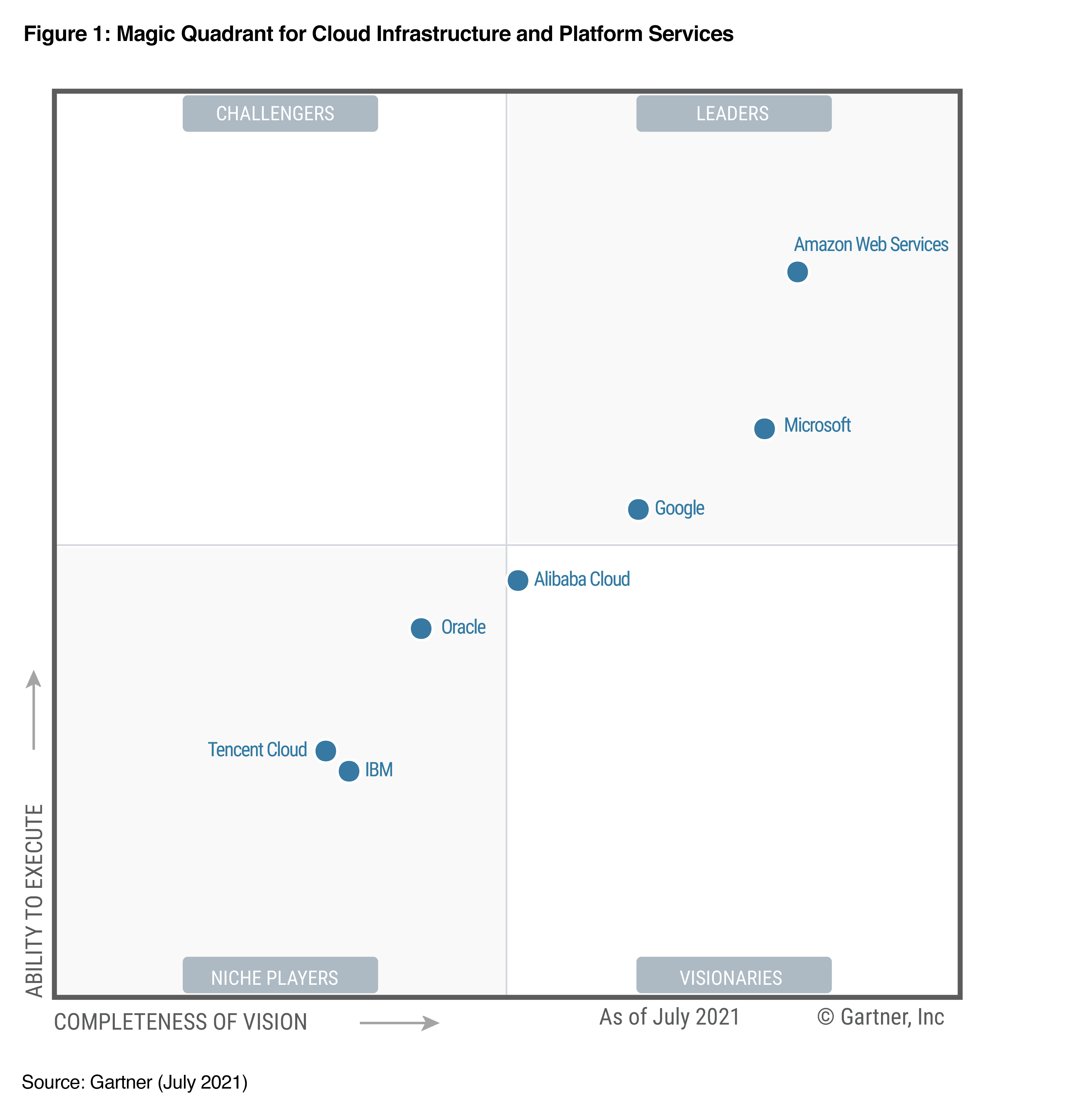A Critical Analysis of the Gartner’s Cloud Infrastructure and Platform Services Magic Quadrant
Executive Summary
- Gartner produces a Cloud Infrastructure and Platforms Services MQ.
- We evaluate this MQ to see if it holds up to scrutiny.

Introduction
Gartner produces a large number of Magic Quadrants highly. Curiously, while these Magic Quadrants are prevalent topics of discussion and determine many purchase decisions, each one that we have evaluated has significant problems that make us question the validity of this highly popular product.
The Cloud Infrastructure and Platform Services Magic Quadrant
The following is the 2021 version of Gartner’s Cloud Infrastructure and Platform Services Magic Quadrant.

Two things immediately pop out to us when reading this MQ.
Observation #1: An MQ Exclusively for Only The Large Vendors
There are many cloud service providers. However, only seven companies made a list, and everyone is large.
Why?
Gartner has stated that which vendors pay has no bearing on who appears or how they appear in the MQs — so why would this MQ be listed to only seven of the most prominent vendors?
So many smaller cloud service providers offer much better pricing and are easier to deal with than these companies. One such company that we use is Digital Ocean.
We have no relationship with Digital Ocean and are not saying this because we desire to promote them.
For many tasks, we find the mega cloud providers to be uncompetitive. The main advantage that the largest or mega-vendors provide is they offer a wide breadth of services, with AWS having the largest.
According to Gartner, they recommend that their clients limit their purchases to these companies. This is the universe of cloud service providers, which is not true, and keeps companies from observing and considering other options that are better for different types of workloads — including, of course, as mentioned, price. But more than this, there is a strong relationship between the size of a vendor and how difficult they are to work with.
Observation #2: Why is Oracle Listed in This MQ?
Oracle only sells its cloud into Oracle accounts, and it only obtains sales from companies that are not running Oracle software in infrequent circumstances. This is what we refer to as “captive cloud.” In this way, its cloud business is similar to SAP and IBM, and these mega-vendors sell cloud bundled with software, which is also bundled.
How Captive Cloud Service Providers Differ
This bundling process is the primary way these captive cloud providers gain cloud business (which they report as entirely voluntary). The vendor proposes that everything is integrated and works better if the customer buys as much from them. In most cases, this is not only not true, but it means accepting mediocre solutions just because they happen to be offered by one company. The ERP mega-vendors are the master of this strategy, as I cover in the article How ERP Systems Are the McDonald’s of Enterprise Software.
Bundle Breaking
If you break the bundle, then the discount offered is significantly reduced. Bundling is covered under US anti-trust law, as I cover in the article How to Understand SAP’s Indirect Access Violate US Laws on Tying Arrangments. However, contrary to popular belief, the US does not enforce its anti-trust laws, so it is extremely common for large companies to do.
This bundling is a primary way that large vendors sell uncompetitive offerings to their customer base. However, Gartner does not mention this is the MQ text, preferring to continue the illusion that all the companies are offering cloud services on a more or less similar approach.
A final observation on the included vendors is if Oracle is listed, why is SAP not listed? SAP pays Gartner a great deal of money, but did they not think it important enough to pay to be included in this MQ? And this points to a problem with Gartner, which is that there is no disclosure on the part of Gartner who pays them or how much. However, who gets included in each MQ is strongly related to the willingness and ability to pay. The payment gets a vendor into the MQ and then determines their ranking. However, Gartner will not disclose any of this in the published MQ. In research circles, such exclusion would typically get one’s research excluded from publication — except of course in biomedical research, where anything goes and the journals even as prestigious as The Lancet are entirely controlled by pharmaceutical companies.
It would be very interesting to see where SAP ranked versus captive cloud companies like IBM and Oracle.
Conclusion
Companies use Gartner Magic Quadrants without understanding how Gartner arrives at their results. Gartner profit maximizes — rather than provides honest research. This means that Gartner works backward from how it can get paid the most (including fees from vendors and buyers), and they determine their views and the Magic Quadrants based upon this. This is why this MQ has the results that it does. The vendors in this MQ can afford to pay Gartner the most. It does not matter to Gartner whether these vendors are challenging to work with or are more expensive because the MQ is not designed around the needs of the buyers but is designed around the needs of Gartner. From the vendor’s perspective, they are also willing to pay Gartner to help “narrow the field.” That is, in a monopolistic fashion, the largest vendors are eager to pay not only to be included but to have a price of admission that is sufficiently high that it keeps smaller and better value vendors out of the Magic Quadrant. This drives buyers to the most expensive solutions and causes vendors that are easier to deal with and lower cost to be sidestepped as not enterprise-ready. Curiously, the scheme behind the Magic Quadrant has not been more widely exposed.